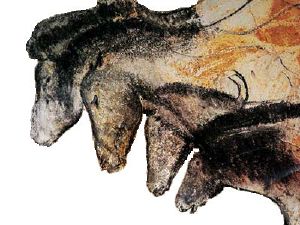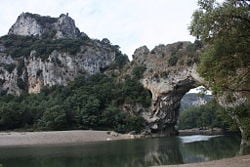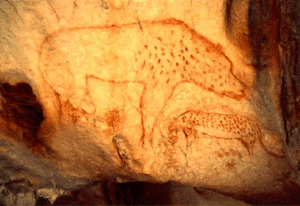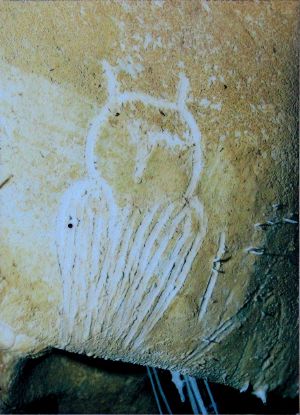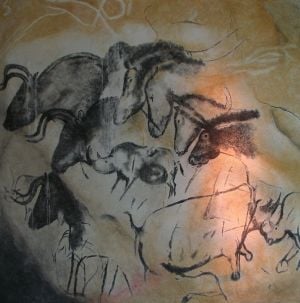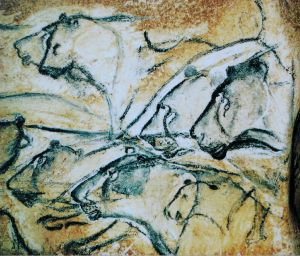Chauvet Cave
The Chauvet Cave [French: La Grotte Chauvet] or Chauvet-Pont-d'Arc Cave is a cave in the Ardèche region of southern France near Vallon-Pont-d'Arc. The cave is located on a limestone cliff above the former bed of the Ardèche River. Containing numerous cave paintings, as well as other evidence of Upper Paleolithic life, it is considered one of the most significant prehistoric art sites.
The cave was first explored on December 18, 1994 by a trio of amateur speleologists: Eliette Brunel Deschamps, Christian Hillaire, and Jean-Marie Chauvet, for whom it was named. Entering the cave they found numerous well-preserved paintings and other human evidence as well as fossilized remains, prints, and markings from a variety of animals, some of which are now extinct. Further study by French archaeologist Jean Clottes has revealed much about the site and its importance. Although the dating has been the matter of some dispute, the paintings in the Chauvet Cave are believed to date from as far back as 30,000 years ago making them some of the oldest discovered cave art. Additionally, their content and style indicate that the images were not primarily created during rituals involved in hunting, as has been suggested for other cave paintings, but they may have been produced for artistic purposes.
Location and Discovery
The Chauvet Cave is situated in the Ardèche region of Southern France. It is on a high cliff that overlooks the valley where the Pont d'Arc, a natural limestone bridge carved out by the Ardèche River, is located. The gorges of the Ardèche region are home to numerous caves, however little prehistoric artwork had been discovered there until the chance discovery of the Chauvet Cave in 1994.
This discovery was made on December 18, 1994 by three amateur speleologists—Jean-Marie Chauvet for whom the cave is named, Eliette Brunel, and Christian Hillaire. A current of air from a small cave attracted their attention and they descended into a large chamber which led to further chambers. Finding bones on the floor that indicated that it had been occupied, they explored deeper. They discovered hundreds of paintings and engravings on the walls and realized that this was a very significant find.
Jean Clottes, scientific advisor to the Ministry of Culture and specialist in prehistoric cave paintings, was quickly called to authenticate the discovery. He immediately recognized that the cave and its paintings were not only genuine but almost perfectly preserved due to the rock slide that had sealed the entrance thousands of years ago. Clottes emerged from the cave after six hours, stunned by his experience viewing what he called "one of the great discoveries of the 20th century.[1]
Experience with other caves containing prehistoric artworks has taught that the caves must be kept closed to the public in order to protect the paintings. Scientific investigation of the cave was carried out under careful conditions to preserve the cave and its contents. A museum has been constructed at Vallon Pont d'Arc that provides visitors with an experience of the prehistoric environment, flora and fauna, and lifestyle of the painters as well as reproductions and movies about the paintings and other findings in the cave. In 2010, filmmaker Werner Herzog was granted limited access to film the paintings inside Chauvet Cave for his 3-D movie Cave of Forgotten Dreams.[2]
Inside the Cave
The Chauvet Cave is uncharacteristically large, extending around 400 meters (1,300 ft). There are numerous chambers and galleries. The soft, clay-like floor of the cave retains the paw prints of cave bears along with large, rounded, depressions that are believed to be the "nests" where the bears slept. Fossilized bones are abundant and include the skulls of cave bears and the horned skull of an ibex.
Based on radiocarbon dating, the cave appears to have been occupied by humans during two distinct Paleolithic periods: the Aurignacian and the Gravettian.[3] Although the dating has been disputed, it has been generally accepted that artwork dates from both the earlier Aurignacian era (30,000 to 32,000 years ago) and the later Gravettian occupation, which occurred 25,000 to 27,000 years ago. The later occupation also left a child's footprints, the charred remains of ancient hearths, and carbon smoke stains from torches that lit the caves. The footprints may be the oldest human footprints that can be dated accurately. After the child's visit to the cave, evidence suggests that the cave was untouched until discovered in 1994.[4]
The Paintings
The walls of the Chauvet cave contain hundreds of animal paintings and engravings. Among those which have been cataloged are at least 13 different species, including those which have rarely or never been found in other ice age paintings. A large number of the paintings depict predators, such as lions, cave bears, panthers, rhinoceroses, owls, hyenas, and mammoths. In fact, such paintings outnumber the more typical horses, deer, and bison found in other caves, animals known to have been hunted.
There are no complete human paintings, although two paintings portray partial figures. There are, however, numerous hand prints and hand stencils. In one chamber near the current entrance, called the Brunel Chamber, there are two collections of painted red dots. It has been ascertained that these are actually hand prints produced by applying pigment to the palm of the hand and pressing it against the wall. Two different sizes of hands have been measured; the larger one probably a man around 1.8 meters (5.9 ft) tall and the other a woman or adolescent.[5] Also, there are many lines and dots which have been interpreted as deliberate abstract design rather than random scratches. There are also two unidentifiable images that have a vaguely butterfly shape to them.
Typical of most cave art, there are no paintings of complete human figures. However, there is one partial "Venus" figure that may represent the legs and genitals of a woman. Close above her is a chimerical figure, the "Sorcerer" or "Man-bison," with the lower body of a man and the upper body of a bison.
The artists who produced these unique paintings used techniques not often observed in other cave art. Many of the paintings appear to have been made only after the walls were scraped clear of debris and concretions. This left a smoother and noticeably lighter area upon which the artists worked. Similarly, a three dimensional quality is achieved by incising or etching about the outlines of certain figures. This visually emphasizes some of the animals and allows torch light to cast shadows about the edges.
The cave consists of two distinct sections divided by a low passage. In the first part red paintings predominate whereas in the deeper area the majority are black. The contents of the two sections also differ. Analysis of the first zone revealed that:
Bear is the most often represented there (73%). It also contains all of the handprints and hand stencils, as well as the big panels of large "hand dots." On the other hand, bison, reindeer, and aurochs are absent.[6]
The second part of the cave includes several areas of high concentration of paintings, such as the Panel of Horses, the Magaceros Gallery, and several panels in the End Chamber including paintings of rhinoceroses, lions, reindeer, and bison. Thus, as well as being a different color, these paintings show different animals from those in the first zone, giving each a clear identity.[6]
Dating
According to Jean Clottes, the Chauvet Cave contains the oldest known cave paintings, based on radiocarbon dating of "black from drawings, from torch marks and from the floors." He concluded that the "dates fall into two groups, one centered around 27,000-26,000 BP and the other around 32,000-30,000 BP."[3]
However, some archaeologists have questioned these dates. Christian Züchner argued, based on comparisons with other prehistoric art in other locations, that the red paintings are from the Gravettian period (c. 28,000–23,000 BP) and the black paintings are from the Early Magdalenian period (early part of c. 18,000–10,000 BP).[7] To explain the discrepancy between these dates and the radiocarbon dates he suggested that the artists could have used charcoal from from wood originally burned by earlier inhabitants, or from "sub-fossil wood buried in river terraces or under glacial dunes."[7] Pettitt and Bahn also suggested that the dating is inconsistent with the traditional stylistic sequence and that there is uncertainty about the source of the charcoal used in the drawings and the extent of surface contamination on the exposed rock surfaces.[8]
More recent stylistic studies have shown that some Gravettian engravings are superimposed on black paintings proving the paintings' older origins.[9] Additionally, a torch mark superimposed on a calcite layer (which took thousands of years to form) that covered a drawing was dated to 26,000 BP. This means that the drawing was significantly earlier than the Gravettian period, and makes it highly improbable that Aurignacian-age charcoal was used by later inhabitants to draw the images.[10]
In 2012, cave art in Cueva de El Castillo (Cave of the Castle) part of the Paleolithic Cave Art of Northern Spain World Heritage Site were dated back to at least 40,800 years, making them the oldest known cave art in Europe, 5,000-10,000 years older than the oldest art in Chauvet Cave.[11]
Meaning and Significance
The discovery of the Chauvet Cave in the Ardèche region was surprising. Previously this area had not been considered a major center of cave art. It is now understood that cave paintings may yet be discovered in areas beyond those already known.
The paintings themselves are also surprising, including numerous animals not usually found in paleolithic art. The fact that animals that would be hunters of the artists rather than potential food, such as lions, bears, and rhinos, were depicted in great numbers impacts the interpretation of cave art. Many have suggested that these early hunter-gatherer people painted images of the animals they hoped to kill prior to a hunting expedition as part of a shamanistic ritual intended to bring fortune to the hunter. While some of the images, such as the "Sorcerer" and the paintings of deer are consistent with this interpretation, many of the paintings in the Chauvet Cave clearly are not.
The quality and style of several of the compositions, especially the black paintings, suggests that they were produced by a single artist, or master artist with assistants.[12] Compositions such as the iconic horses appear as pieces produced for aesthetic purposes, implying that this early culture recognized the value of, and had time for, purely artistic pursuits.
After examining its paintings, Jean Clottes considered the Chauvet Cave to rank "among the great prehistoric sanctuaries."[1] He was convinced that the paintings in the Chauvet Cave date back over 30,000 years. Not only that, he judged their work to be outstanding both in terms of their content and technique, and perhaps of even great importance, they provide a connection between contemporary people and human beings who lived so long ago:
Sophisticated artists were at work 30,000 years ago when these images were made, and their stunning creations still speak to us today.[1]
Notes
- ↑ 1.0 1.1 1.2 Jean Clottes, Ancient Grand Masters: Chauvet Cave, France, TIME Europe, 2005. Retrieved September 15, 2010.
- ↑ Larry Rohter, "Prehistoric Cave with a Hornet on the Wall," The New York Times (April 22, 2011). Retrieved April 27, 2011.
- ↑ 3.0 3.1 Jean Clottes, Chauvet Cave: The Art of Earliest Times (University of Utah Press, 2003, ISBN 0874807581).
- ↑ Gregory Curtis, The Cave Painters: Probing the Mysteries of the World's First Artists (Anchor, 2007, ISBN 978-1400078875).
- ↑ Dominique Baffier and Valérie Feruglio, First observations of two layers of dots at Chauvet-Pont-d'Arc Cave (Pont-d'Arc Valley, Ardèche, France), INORA International Newsletter on Rock Art 21(1998). Retrieved September 29, 2010.
- ↑ 6.0 6.1 Jean Clottes, Bernard Gély, and Yanik Le Guillou, Counts of the animal representations at Chauvet-Pont-d'Arc Cave in 1998, INORA International Newsletter on Rock Art 23(1999). Retrieved September 29, 2010.
- ↑ 7.0 7.1 Christian Züchner, Grotte Chauvet Archaeologically Dated. Communication at the International Rock Art Congress IRAC ´98 - Vila Real – Portugal, 6-12 September 1998. Retrieved September 21, 2010.
- ↑ Paul Pettitt, Art and the Middle-to-Upper Paleolithic transition in Europe: Comments on the archaeological arguments for an early Upper Paleolithic antiquity of the Grotte Chauvet art, Journal of Human Evolution, (2008) (abstract)Retrieved September 29, 2010.
- ↑ Emmanuel Guy, The Grotte Chauvet: A completely homogeneous art?, Paleoesthetique.com, February 2004. Retrieved August 26, 2010.
- ↑ French Ministry of Culture, Dating The Cave of Chauvet-Pont-d'Arc. Retrieved September 29, 2010.
- ↑ Jonathan Amos, Red dot becomes 'oldest cave art' BBC News, June 14, 2012. Retrieved October 10, 2013.
- ↑ Jean Clottes and Valérie Féruglio, The Significance of the Cave The Cave of Chauvet-Pont-d'Arc, French Ministry of Culture website. Retrieved September 17, 2010.
ReferencesISBN links support NWE through referral fees
- Chauvet, Jean-Marie, Eliette Brunel Deschamps, and Christian Hillaire. Dawn of Art: The Chauvet Cave. New York, NY: Harry N. Abrams, 1996. ISBN 0810932326
- Chauvet, Jean-Marie, Eliette Brunel Deschamps, and Christian Hillaire. Chauvet Cave: The Discovery of the World's Oldest Paintings. Thames & Hudson Ltd, 2001. ISBN 0500282862
- Clottes, Jean. Chauvet Cave: The Art of Earliest Times. University of Utah Press, 2003. ISBN 0874807581
- Clottes, Jean. Return To Chauvet Cave, Excavating the Birthplace of Art: The First Full Report. Thames & Hudson Ltd, 2003. ISBN 0500511195
- Clottes, Jean. Ancient Grand Masters: Chauvet Cave, France TIME Europe: European Journey 2005. Retrieved September 15, 2010.
- Clottes, Jean. Cave Art. Phaidon Press Inc., 2008. ISBN 978-0714845920
- Curtis, Gregory. The Cave Painters: Probing the Mysteries of the World's First Artists. Anchor, 2007. ISBN 978-1400078875
- Guy, Emmanuel. The Grotte Chauvet: A completely homogeneous art? Paleoesthetique.com, February 2004. Retrieved August 26, 2010.
- Züchner, Christian. Grotte Chauvet Archaeologically Dated. Communication at the International Rock Art Congress IRAC ´98 - Vila Real – Portugal, 6-12 September 1998. Retrieved September 21, 2010.
External links
All links retrieved December 4, 2023.
- The Cave of Chauvet-Pont-d'Arc French Ministry of Culture information site; includes an interactive map with photos.
- Chauvet Cave (ca. 30,000 B.C.E.) on the Metropolitan Museum of Art's Timeline of Art History
- The Chauvet Cave: The Paleolithic Cave Paintings of Prehistoric France The Bradshaw Foundation, with contributions by Jean Clottes.
- Chauvet Cave Don's Maps.
- Cave of Forgotten Dreams at the Internet Movie Database
Credits
New World Encyclopedia writers and editors rewrote and completed the Wikipedia article in accordance with New World Encyclopedia standards. This article abides by terms of the Creative Commons CC-by-sa 3.0 License (CC-by-sa), which may be used and disseminated with proper attribution. Credit is due under the terms of this license that can reference both the New World Encyclopedia contributors and the selfless volunteer contributors of the Wikimedia Foundation. To cite this article click here for a list of acceptable citing formats.The history of earlier contributions by wikipedians is accessible to researchers here:
The history of this article since it was imported to New World Encyclopedia:
Note: Some restrictions may apply to use of individual images which are separately licensed.
